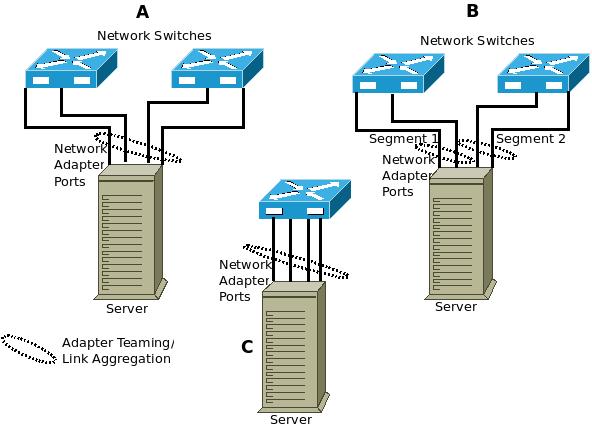Server Adapter Teaming & Link Aggregation
It is possible to group multiple server adapters (NIC) / server adapter ports to achieve a combined throughput capacity of multiple adapter ports/ links. In the process, we can also achieve fault tolerance, load balancing & high availability for server adapters (NIC). Let us explore Server Adapter Teaming & Link Aggregation, in this article.
What is Server Adapter Teaming?
It is the process of combining multiple adapter ports in the same server to function as a single virtual adapter (with a single IP address, in most cases) in order to achieve a higher (combined) connectivity throughput. For example, its possible to team two adapters with a single port of 1 Gbps each, to make it function like a single adapter with a speed of up to 2 Gbps. These two individual links are load balanced, so that there is equal distribution of traffic between them, and hence combined maximum throughput (as far as possible) can be obtained. Server adapter teaming is mostly a software enabled function. With Server Adapter teaming, one can achieve High Availability (Fault Tolerance) for the server adapter connectivity.
What are the benefits of Server Adapter Teaming?
- Higher throughput – Combined bandwidth of two or more ports/ links.
- Easier upgradation – If 1 Gbps NIC card performance is not sufficient for a particular server, another NIC of similar capacity can be teamed with this to achieve a higher throughput. This might be cheaper and more efficient than buying a 10 Gbps adapter and discarding the 1 Gbps adapter altogether.
- Load balancing – The traffic in each link that goes out of the teamed ports is load balanced with other links to get a better performance.
- High Availability – Depending on the configuration, server adapter teaming gives fault tolerance (and hence high availability to the server) in the event of: Network Switch failures, Switch Mis-Configurations (resulting in hanging/ non availability of the switch), Network cable (connecting the server and the switch) failure/ accidental disconnection, PCI Slot failures & Server Adapter/ Port failure.
- Virtual Servers – If virtualization is used to create many server images within a single server, adapter teaming gives the higher throughput required in such situations.
- Its possible (but not recommended) to team multiple vendor adapters/ multi-capacity adapters (100 Mbps/ 1000 Mbps).
- Multiple ports built in to the same adapter/ motherboard of a server can be teamed together.
- If both adapters and network switches support IEEE 802.3ad Link Aggregation standard, both incoming and outgoing traffic (from the server adapter) can be load balanced. Otherwise, only the outgoing traffic is load balanced.
- Up to 8 Ports can be teamed together with certain server adapters.
 Some configurations for server adapter teaming, are shown above.
Some configurations for server adapter teaming, are shown above.
When you consider the scenario in ‘C’, a single adapter with four ports (or) multiple adapters (2×2 ports; 4×1 port) can be teamed together and connected to the same switch. This achieves combined throughput of the four ports and high availability (against the failure of any single route) but does not account for switch failure. If the switch fails, all the links are down and cannot connect to the network.
Now consider the scenario in ‘A’. Among the four adapter ports available, two of them connect to one switch and two more connect to another switch. This way, even if one switch fails, the traffic continues to flow through the other.
In the scenario shown in ‘B’, each set of teamed ports to connecting to individual switches carry the traffic meant for different subnets. This provides for better segmentation of network and dedicated links for each subnet. The multiple adapter ports connecting to each switch (and each subnet) are teamed together for higher performance.
In most of the cases, multiple adapters/ adapter ports advertise a single IP address (and single MAC address) when they are teamed together. It becomes like a single virtual adapter with a higher (combined) port capacity. The above shown scenarios are just examples, and adapter teaming configurations are implemented differently by different vendors.
excITingIP.com
You could stay up to date with the various computer networking/ related IT technologies by subscribing to this blog with your email address in the sidebar box that says, ‘Get email updates when new articles are published’.